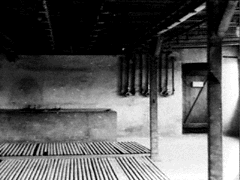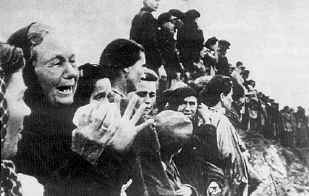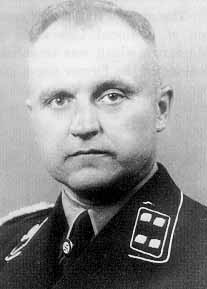|

|
|
The Making
The Majdanek
Concentration Camp is located about 3 miles from the Polish city of
Lublin. The decision to make the camp came from Heinrich Himmler during
his visit to Lublin in July 1941. The Nazis brought in 2,000 Soviet POWs
to build the camp. With no barracks these prisoners were forced to sleep
and work in the cold outdoors with no water and no toilets.
|
|
The Fields
The camp at
Majdanek was laid out into six sections called fields. Each field has
two rows of barracks on each side of an open area, which has gallows for
hanging prisoners. Field 1 was next to the entrance and fields 2,3,and 4
went up a slight slope with field 5 and 6 at the top.
|

This is Field three at
Majdanek, you can see barracks and watch towers in the background. |
|
At
first, the Russian POWs were in field 1 and the Jewish women and
children were in field 5, but later field 1, right next to the gas
chambers, was assigned to the Jews. |
|
The
Crematoria
When the camp
first opened, the bodies of the dead prisoners were buried in mass
graves, but in June 1942 on, they were burned in the first crematoria or
on pyres made from the chassis of old trucks. The first crematoria had 2
ovens, which were brought to Majdanek from the Sachsenhausen camp in
Germany. The first crematoria is no longer at Majdanek.
|
|
The
second crematoria was outfitted with 5 ovens which were fueled with
coke. It was a wooden building but later it got burned down by the
Germans. |
|
In
the crematoria there is a room were they take out all the valuables from
a persons body after they have been gassed. When the camp was liberated
there were still remains of the bodies in the ovens of the crematoria.
The last crematoria was built in 1943 which is still standing today. |
|
Barracks
At first, the
prisoners had to sleep on straw filled thin pallets on the bare ground
in buildings that had no wooden floors. These buildings were horse
barns, which could be erected as quickly as possible. In just one
barrack they stuffed 500 to 800 prisoners in a room when it only held
about 250 people
|
|

This
gas chamber is the biggest in Majdanek. You can see the air tight
door and a peep hole in the door.
|

This is a Majdanek gas chamber. You can see the
blue stains on the walls from the Zyklon B pellets. There is also
finger nail scratchings on the walls from prisoners trying to get
out.
|
|
After
gassing the victims, Sondo Kommandos ( special prisoners that could
partially be trusted) took the bodies up a slope to the crematoria were
the bodies would then be cremated. |
|
Erntefest
The worst incident ever to happen at Majdanek was on November 3,1943. It
was called ''Bloody Wednesday,'' but the Germans called it Erntefest, or
the harvest festival. The reason this was the worst incident was because
18,000 Jews were murdered in a single day. The SS men shot the Jews in a
group of one hundred. They were shot in pits while loudspeakers played
dance music,'' Beer Barrel Polka,'' to drown out the screams and to
reduce the noise from the shooting. |
|
Conditions
at Majdanek
While it sill
was a Nazi camp, conditions at Majdanek were much worse than any other
concentration camp. Majdanek had no sewer system in the camp. They had
no toilets they had to just go on the ground. At night when the
prisoners were forbidden to leave the barracks, they used wooden
buckets. In Lublin the civil authorities would not let the camp be
connected to the main sewer line, but in May 1942 Majdanek finally got a
sewer system. And in 1943 the camp got running water, but the prisoners
got only one shower or bath a month. This lack of sanitation caused many
deaths from deceases like typhus, tuberculosis, and dysentery.
|
|
No Escape
Majdanek was
very strict about not letting Jews escape. It has double barbed wire
fence with a high voltage system all around the camp, including nine
watch towers equipped with mobile search lights.
|
|
Transporting
the Jews
During the Nazi
occupation, there was no railroad to bring in prisoners directly in to
the Majdanek camp. The prisoners were brought to Lublin in long cattle
cars then they were loaded up in trucks and brought to Majdanek.
|
|
|
|
Liberation
of Majdanek
The Germans
could not shut down Majdanek in such an orderly fashion. With the
Russian army advancing westward the Germans evacuated the camp in March
1944. About 15,000 prisoners were transported I trains to camps in
Europe like Auschwitz, Gross-Rosen, Ravensbruck, Natzwiler, Mathausen,
Lodz, and Plaszow. And about another 1,000 prisoners weremarched off by
foot just the day before the liberation.And some prisoners that were to
ill to walk were abandoned at Majdanek.
|
.
This
is a picture of Jews Liberation Day at Majdanek |
|
When the Russians overran the
camp in July 23, 1944 they finally saw the horror of the death camps.
They brought in representatives from the International Red Cross and the
news media to view the gas chambers, crematoria, and the survivors,
which were a little less than skeletons. But after all that the United
States and Great Britain hesitated to believe what had happened. The
Germans did not want a repeat of Majdanek. So through the last half of
1944, the Germans worked furiously to complete their deadly work in
preparation for the evacuation of Auschwitz the last remaining death
camp.
|
|
Death Toll
When the
Majdanek death camp was liberated, the Soviet Union first said that 1.7
million people had been killed there by the Nazis but at the Nuremberg
trial of the Nazi war criminals in 1946, the Soviets charged the Nazi
leaders at Majdanek with killing only 1.5 million people at Majdanek. By
1960 the number of people murdered by the Nazis at Majdanek declined to
350,000. This was corrected by the guidebook, when it was learned that
no more than 300,000 people had even been sent to Majdanek. The actual
death toll was 250,000 people killed at Majdanek.
|
|
Commandants
and Convictions
There were many
commandants at Majdanek. The first was Karl Koch, then Max Koegel, and
followed by Martin Weiss, and the last was Arthur Liebehenschel. In 1944
a special Soviet Nazi Crime Commission investigated the scenes at
Majdanek.
|

This is Karl
Koch the first commandant at Majdanek. |
|
Only
some of the 1,300 staff members were put to trial after the war. In
November 1944 six SS men who worked at Majdanek were tried in Lublin,
four of them were sentenced to death, the other two-committed suicide
right before the trial |
|
From
1946 to 1948 in Lublin 95 SS men who worked at Majdanek were put to
trial. Seven of them were sentenced to death and the rest of them were
sentenced to long-terms in prison. There were 800 cases of cruelty and
corruption total in the death camps. |
|
National
Museum
In 1944 a National Museum was built on the site of Majdanek.
It holds the remains of the camp as well as a permanent exhibition,
administers archive, and edits research works on the history of the
camp.
|
| David Roth
Rossville Jr. High -7th Grade
2002 Holocaust Projects |
Bibliography |
|
|
|